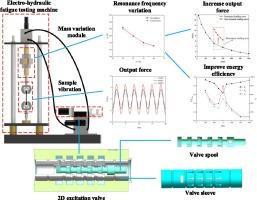Advancements in electrohydraulic fatigue testing: Innovations in variable resonance frequency control and comprehensive characterization
IF 8.9
1区 工程技术
Q1 ENGINEERING, MECHANICAL
引用次数: 0
Abstract
This study addresses the challenge in electro-hydraulic fatigue testing machines where increasing excitation frequency leads to reduced output load amplitude, making it difficult to optimize both frequency and amplitude simultaneously. A new approach is introduced with the variable resonance fatigue testing machine controlled with 2D excitation valves. This technique involves adjusting the system’s intrinsic frequency by altering its mass, aligning the excitation frequency with the intrinsic frequency, and leveraging resonance energy to enhance excitation amplitude for broad-range resonance near the resonance point. The relationship between the system’s intrinsic frequency, the equivalent mass of the upper connector, and the upper fixture is explored, yielding analytical solutions. Experimental research validates these simulations, in the resonance condition, the fatigue testing machine energy efficiency can reach 94 %, to further verify the fatigue testing machine in the resonance condition to realize the High energy efficiency. Demonstrating that the system’s intrinsic frequency decreases with increasing mass, allowing for a broad frequency resonance between 200 and 300 Hz. Operating in a broadband resonance region, the output load force is increased by 60 %–95 % and the system flow is reduced by 20 %–30 %. This mass-adjustment technique effectively alters the system’s intrinsic frequency, expanding the electro-hydraulic fatigue testing machine’s application scope.

电液疲劳测试的进步:可变共振频率控制和综合表征方面的创新
在电液疲劳试验机中,激励频率的增加会导致输出载荷振幅的减小,从而难以同时优化频率和振幅,而本研究正是要解决这一难题。通过二维激励阀控制的可变共振疲劳试验机引入了一种新方法。该技术包括通过改变质量来调整系统的固有频率,使激励频率与固有频率保持一致,并利用共振能量来提高激励振幅,从而在共振点附近实现宽范围共振。我们探讨了系统固有频率、上部连接器等效质量和上部夹具之间的关系,并得出了分析解决方案。实验研究验证了这些模拟,在共振条件下,疲劳试验机的能效可达 94%,进一步验证了疲劳试验机在共振条件下实现高能效的可能性。证明系统的固有频率会随着质量的增加而降低,从而实现 200 赫兹到 300 赫兹之间的宽频共振。在宽频共振区工作时,输出负载力增加 60%-95%,系统流量减少 20%-30%。这种质量调整技术有效地改变了系统的固有频率,扩大了电动液压疲劳试验机的应用范围。
本文章由计算机程序翻译,如有差异,请以英文原文为准。
求助全文
约1分钟内获得全文
求助全文
来源期刊

Mechanical Systems and Signal Processing
工程技术-工程:机械
CiteScore
14.80
自引率
13.10%
发文量
1183
审稿时长
5.4 months
期刊介绍:
Journal Name: Mechanical Systems and Signal Processing (MSSP)
Interdisciplinary Focus:
Mechanical, Aerospace, and Civil Engineering
Purpose:Reporting scientific advancements of the highest quality
Arising from new techniques in sensing, instrumentation, signal processing, modelling, and control of dynamic systems
 求助内容:
求助内容: 应助结果提醒方式:
应助结果提醒方式:


